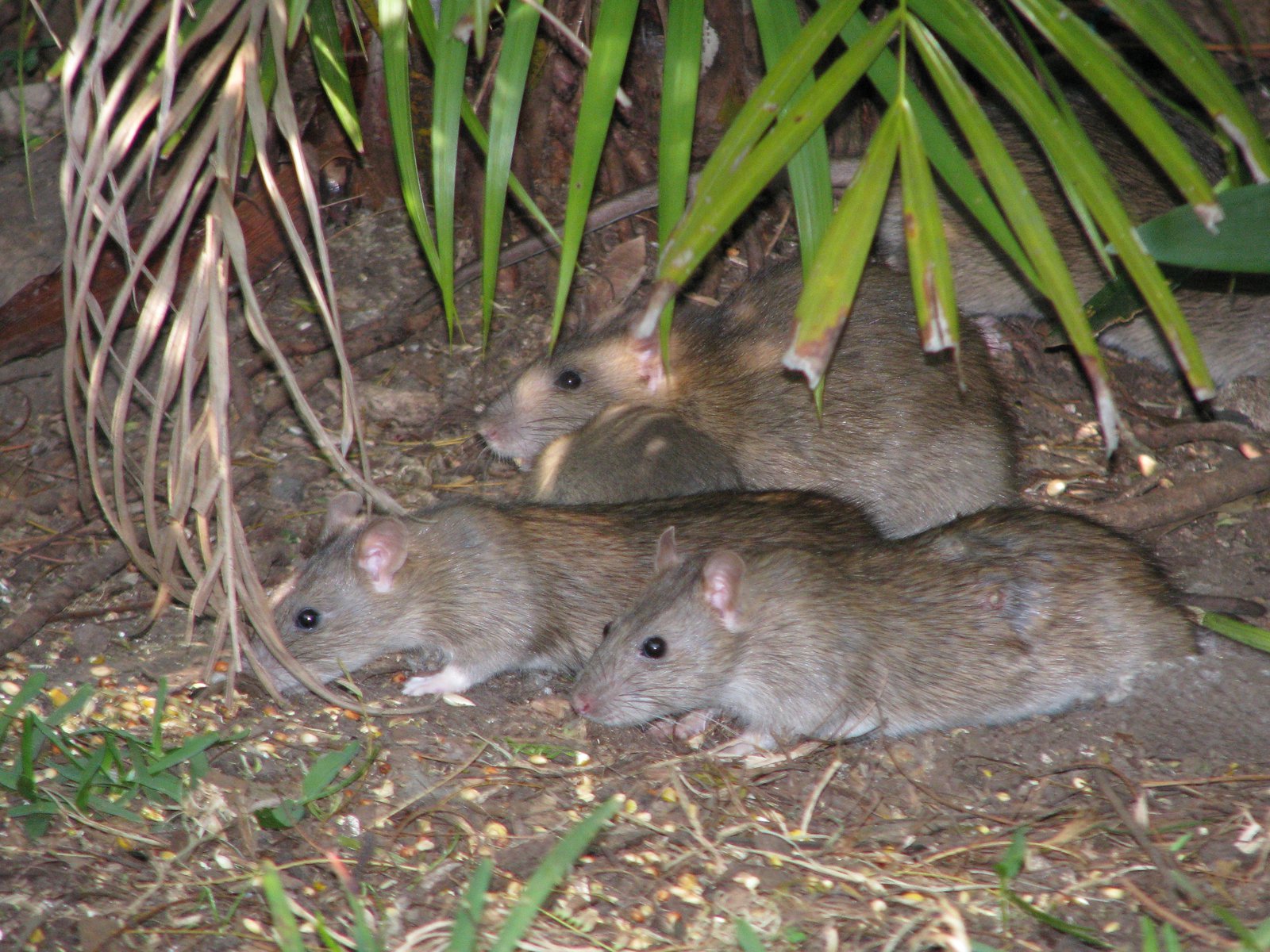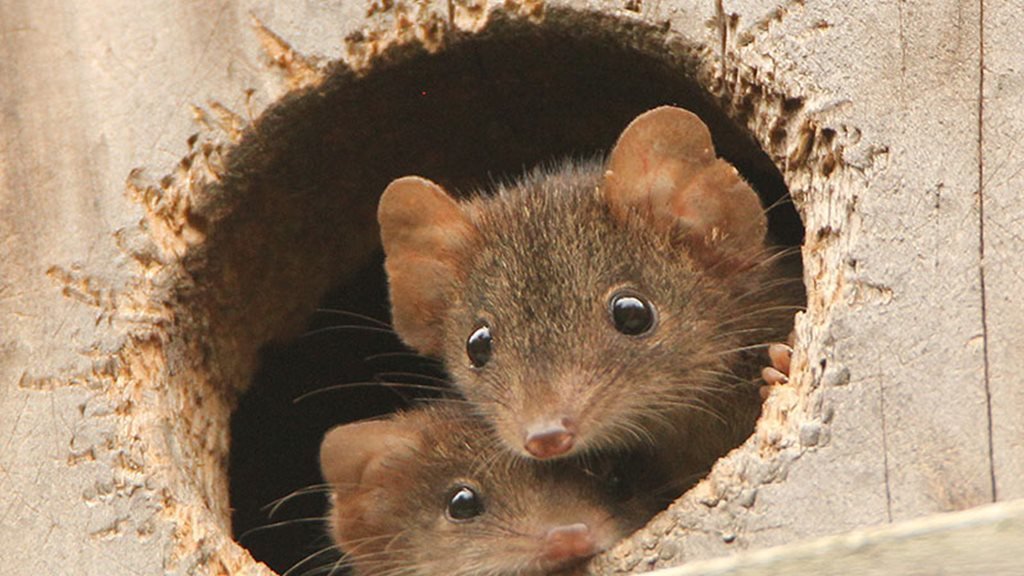Is it a rat?
On this page...
Many people may think that they have seen a baby Ring-tailed Possum or a native rat species in their backyard; however, in many cases it turns out to be a Black Rat Rattus rattus, which is an introduced species and an age-old pest in and near human habitation.

How can I tell whether I've seen a Black Rat or some other small mammal?
Rat identifications can be difficult to differentiate from photos, as the variation within species is considerable. Juvenile rodents especially are near impossible to differentiate without examining them in person.
Behaviour
The first thing to look at is the animal's behaviour:
- Is it active during both day and night, and is it relatively fearless around humans?
- Is it an agile climber, often seen in fruit trees, scaling fences and electrical wires or the roof of a house?
- Have you found a nest in your roof, made of shredded materials such as paper, insulation and other debris?
- Have you seen evidence of it feeding on grains and discarded foodstuffs, as well as fruit and even pet food?
All of these traits combined are characteristic of the introduced Black Rat, Rattus rattus, which is often called the 'Roof Rat' for its nesting and climbing habits.
Brown Rats are also an introduced rodent that shelter under bushes, in sewers and other urban sites, or construct deep burrow systems and make nests of shredded materials. Brown Rats are closely associated with humans and are common in coastal urban areas, and have a much thicker, completely naked tail and a 'blunter' snout compared to other species.
Native rats, such as the Bush Rat, are much shyer animals, and are not found in places where human traffic is frequent - they prefer to nest in dense forest understorey, sheltering in short burrows under logs or rocks, and they line their nests with grass. In fact, native rats such as the Bush Rat, have not been recorded in the inner city for many years.
Possums do nest in roofs, but are mainly active at night, and although they are agile climbers, are heavier than rats in their movements. They may eat fruit and other human leftovers, but tend to feed on native vegetation, and are not found as often as rats are scavenging indoors and/or ransacking stored foodstuffs.
Summary:
- If they are in large numbers and in urban areas/seen in daylight, it's most likely a Black or Brown Rat.
- If they are climbing, it's most likely a Black Rat, as the other rat species are poor climbers.

Black Rat, Rattus rattus.
Image: Dan ForsterCC-BY-NC 4.0 (Int) Supplied as http://creativecommons.org/licenses/by-nc/4.0/
Tail
The next thing to look at the appearance of its tail. Is it:
- Long in relation to the body, sparsely haired and scaly and not used to grip branches when climbing? It is a Black Rat.
- Shorter than the body length? It is a Bush Rat.
Note: Bush Rats can have their tail as long (but not longer) as their body - which can overlap with a Black Rat if the Black Rat had a tail shorter than usual. - Long, with a white tip, furred on the upper surface and naked underneath, and used to grip branches or held with the end slightly curled? It is a Ring-tailed Possum.
- Short scaly tails, shorter than its body? It is a Brown Rat. Brown Rats have a much thicker, completely naked tail and a 'blunter' snout compared to other species.
In summary, the Black Rat's long tail length is the easiest way to identify this species, as no other rat species have their tail longer than their body length.
Size, shape and colour
Lastly, the overall size, shape and colour of the animal should be looked at:
- Black Rats are about 16 cm to 20 cm long, and are charcoal grey to black or light brown above, cream or white below, with a sleek smooth coat. They have big thin ears and quite a round face.
- Bush rats also have light coloured/transparent hairs on the tops of their feet, and the fur often extends over their claws, where as Black Rats have short, dark hairs on the tops of their feet. Unfortunately, a Bush Rat with dirt on its feet can look like it has dark hairs, so this isn't an ideal identifying characteristic without a 'clean' individual.
- Antechinus are most easily identified by their crinkled ears, often with a notch in them, making it look like they have two lobes on each ear. They also have small, sharp teeth the whole way along their jaw instead of the enlarged incisors of the rats.
Ringtail Possum
A Ring-tailed Possum of similar size to a Black Rat would still be in its mother's pouch or on her back, and would not be fully furred.
An adult possum is much larger than a rat, reaching about 30 cm to 35 cm in length. The coat colour is quite variable, the ears are short with a white patch behind, and the prehensile (gripping) tail has a white tip.

Ringtail possum, Pseudocheirus peregrinus
Image: G B Baker© Australian Museum
Native Bush Rats
The Bush Rat is charcoal grey to black or light brown above, cream or white below; has a sleek smooth coat, is grey to grey-brown or reddish above, grey or cream below and has dense soft fur. The ears are rounded.

CC-BY-NC 4.0 (Int) Supplied as http://creativecommons.org/licenses/by-nc/4.0/
Brown Rats
Brown Rats, Rattus norvegicus have short scaly tails, shorter than their body (body 18-25 cm long, and their tails 15-21 cm long). They have one pair of distinctive chisel shaped incisors with hard yellow enamel on front surfaces. Their heads have a blunt muzzle with long whiskers, medium sized ears. The coat colour is grey-brown above, white to grey below with shaggy bristly fur.

© Kim Robertson
What about other small native mammals?
One animal that is sometimes seen and mistaken for a rat is in fact a small carnivorous marsupial - the Antechinus.
While there are several species of Antechinus in Australia, they share several traits in common, which, taken together, can set them apart from rodents such as rats and mice. These include:
- Their front teeth:
- Rodents have one pair of distinctive chisel shaped incisors that have hard yellow enamel on the front surfaces.
- Antechinuses have four rows of small sharp incisors.
- Their ears. Many antechinus species have large thin crinkly ears that have a notch in the margin, although not all will have this notch.
- Their tail. Antechinuses have a sparsely haired tail, which is the same length as the body or shorter (65-110mm).
- Their habits. Antechinuses are mainly nocturnal insect eaters, which are found in forest habitats and are not found often in urban areas. They shelter in spherical nests in hollow logs or crevices, but can sometimes found nesting in furniture in bush areas or farms.
- If they are climbing, it's a near certainty that it's a Black Rat, as the other rat species are poor climbers. However the Antechinus can also climb, but can be differentiated by their crinkled ears.
Support our research
Help us to protect our vital natural and cultural heritage for generations to come. With your support, our scientists, explorers and educators can continue to do their groundbreaking work.
Make a donation





